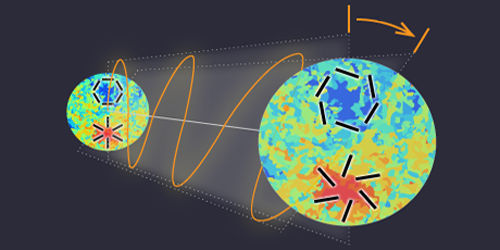Hints of Cosmic Birefringence?
Researchers are increasingly scrutinizing the polarization of the cosmic microwave background (CMB)—the oldest light in the Universe—for signs of new physics. One such sign would be a slight rotation of this polarization, as if the light had passed through a birefringent material with a polarization-dependent refractive index. This “cosmic birefringence” isn’t predicted by the standard model and could arise from the coupling of CMB photons to hypothetical particles and fields. So far, experiments are consistent with zero birefringence, but their sensitivity has been hampered by certain systematic errors. Using an approach that mitigates such errors, Yuto Minami of the High Energy Accelerator Research Organization, Japan, and Eiichiro Komatsu of the Max Planck Institute for Astrophysics, Germany, and the University of Tokyo have analyzed CMB data from the Planck satellite and found tantalizing hints of a faint birefringence signal [1].
Systematic errors in tests of cosmic birefringence mostly derive from an unavoidable inaccuracy in the detector polarization angle. Since this inaccuracy has the same effect as a cosmic-birefringence-induced rotation , this miscalibration poses the biggest limit to detection sensitivity. Minami and Komatsu eliminated contributions from by correlating CMB measurements (affected by both and ) with measurements of foregrounds produced by microwave sources in our Galaxy (only affected by ). Analyzing Planck data, they found a 99.2% likelihood that is nonzero. This likelihood is a long stretch from the 5-sigma confidence needed for a discovery, but next-generation CMB detectors using the new method could strengthen the result. If confirmed, it would be a game-changing discovery, say the authors.
–Matteo Rini
Matteo Rini is the Editor of Physics Magazine.
References
- Y. Minami and E. Komatsu, “New extraction of the cosmic birefringence from the Planck 2018 polarization data,” Phys. Rev. Lett. 125, 221301 (2020).




